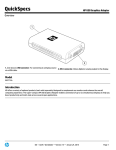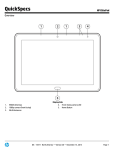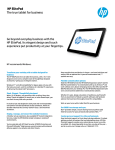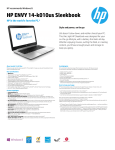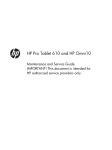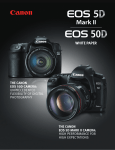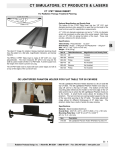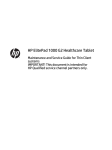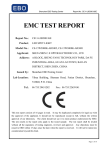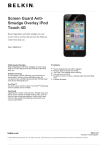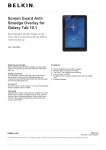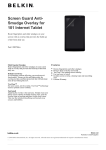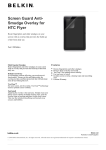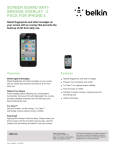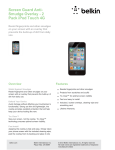Download HP ElitePad ST Suction Cup
Transcript
HP ElitePad 900 Maintenance and Service Guide IMPORTANT! This document is intended for HP authorized service providers only. © Copyright 2013 Hewlett-Packard Development Company, L.P. Bluetooth is a trademark owned by its proprietor and used by Hewlett-Packard Company under license. Intel is a U.S. registered trademark of Intel Corporation. Microsoft and Windows are U.S. registered trademarks of Microsoft Corporation. SD Logo is a trademark of its proprietor. The information contained herein is subject to change without notice. The only warranties for HP products and services are set forth in the express warranty statements accompanying such products and services. Nothing herein should be construed as constituting an additional warranty. HP shall not be liable for technical or editorial errors or omissions contained herein. First Edition: January 2013 Document Part Number: 698484-001 Safety warning notice WARNING! To reduce the possibility of heat-related injuries or of overheating the device, do not place the device directly on your lap or obstruct the device air vents. Use the device only on a hard, flat surface. Do not allow another hard surface, such as an adjoining optional printer, or a soft surface, such as pillows or rugs or clothing, to block airflow. Also, do not allow the AC adapter to contact the skin or a soft surface, such as pillows or rugs or clothing, during operation. The device and the AC adapter comply with the user-accessible surface temperature limits defined by the International Standard for Safety of Information Technology Equipment (IEC 60950). iii iv Safety warning notice Table of contents 1 Product description ........................................................................................................... 1 2 External component identification ..................................................................................... 4 Front ....................................................................................................................................... 4 Rear ....................................................................................................................................... 5 Top ........................................................................................................................................ 6 Bottom .................................................................................................................................... 7 3 Illustrated parts catalog .................................................................................................... 8 Service tag .............................................................................................................................. 8 Computer major components ..................................................................................................... 9 Adapter cables ...................................................................................................................... 12 Docking station and accessories .............................................................................................. 13 Miscellaneous parts ................................................................................................................ 14 Power components ................................................................................................................. 15 Sequential part number listing .................................................................................................. 16 4 Removal and replacement procedures ............................................................................ 20 Preliminary replacement requirements ....................................................................................... 20 Tools required ......................................................................................................... 20 Service considerations ............................................................................................. 20 Plastic parts ............................................................................................. 20 Cables and connectors ............................................................................. 20 Drive handling ......................................................................................... 21 Grounding guidelines .............................................................................................. 21 Electrostatic discharge damage .................................................................. 21 Packaging and transporting guidelines ........................................ 23 Component replacement procedures ........................................................................................ 25 Service tag ............................................................................................................. 25 Display assembly .................................................................................................... 26 WWAN module ..................................................................................................... 34 v GPS module ........................................................................................................... 36 Volume button board ............................................................................................... 38 WLAN module ........................................................................................................ 40 System board ......................................................................................................... 42 Microphones .......................................................................................................... 47 Webcams .............................................................................................................. 48 Communications cable ............................................................................................. 50 Power button board ................................................................................................. 51 WLAN ribbon cable ................................................................................................ 52 Battery ................................................................................................................... 54 WLAN antenna ...................................................................................................... 55 Docking connector cable .......................................................................................... 56 Speaker assembly ................................................................................................... 58 5 HP BIOS Settings ............................................................................................................ 59 Using HP BIOS Settings ........................................................................................................... 59 Starting HP BIOS Settings ......................................................................................... 59 View Information ...................................................................................... 59 BIOS Settings ........................................................................................... 60 Boot options ............................................................................. 60 Device configurations ................................................................ 60 BIOS password ......................................................................... 60 Updating the BIOS .................................................................................................. 61 Determining the BIOS version .................................................................... 61 6 Specifications ................................................................................................................. 62 Tablet specifications ............................................................................................................... 62 7 Backup and recovery ...................................................................................................... 63 Backing up your information .................................................................................................... 63 Performing a system recovery .................................................................................................. 64 Using f11 recovery tools .......................................................................................... 64 Changing the boot device order ............................................................................... 65 Using Windows Refresh for quick and easy recovery ................................................... 65 Remove everything and reinstall Windows ................................................................. 66 8 Power cord set requirements .......................................................................................... 67 Requirements for all countries .................................................................................................. 67 Requirements for specific countries and regions ......................................................................... 68 vi 9 Recycling ........................................................................................................................ 69 Index ................................................................................................................................. 70 vii viii 1 Product description Category Description Product Name HP ElitePad 900 Processor Intel® Atom z2760 1.50-GHz processor (burst up to 1.80-GHz), 533-MHz front-side bus (FSB), 512-KB L2 cache, soldered to system board Graphics Intel universal memory architecture (UMA), shared with system memory Panel 10.1-in., WXGA (1280×800), UWVA, 50% CG, 400-nit, active pen and MultiTouch capacitive digitizer, chemically-strengthened glass with antismudge Memory On-board 533-MHz, LPDDR2, 2048-MB memory (soldered to system board); system supports a 2048-MB × 1 (8 pieces, 128 MB × 16 chips) configuration Primary storage 64- or 32-GB embedded MultiMedia Card (eMMC), soldered to the system board Optical drive No internal optical drive or USB-powered optical drive is supported Audio and video 2 integrated stereo speakers, each 1.5 W HD Audio SRS Audio One digital microphone 2 fixed integrated webcams (user-facing webcam: 1080p camera; rear-facing webcam 8-MP camera with LED flash) Ethernet No Ethernet support Wireless Integrated wireless local area network (WLAN) options by way of wireless module Integrated WLAN antennas Support for the Qualcomm Atheros AR6004 802.11a/b/g/n 2×2 WiFi + AR3002 BT4.0 Combo Adapter 1 Category Description Wireless (continued) Integrated wireless wide area network (WWAN) options by way of wireless module Integrated world-wide/5-band WWAN antennas Secured by subscriber identity module (SIM) Support for the following WWAN formats: ● HP hs3120 HSPA+ Mobile Broadband Module ● HP hs3121 HSPA+ Mobile Broadband Module ● HP hs3124 HSPA+ Mobile Broadband Module Support for no WWAN option Integrated near field communication (NFC) module and antennas External media cards Flash Media slot (with push-push technology) supporting microHCSD cards up to 64-GB Ports ● Audio-in (mono microphone)/audio-out (stereo headphone) combo jack ● HP ElitePad 900-proprietary docking connector ● Accelerometer + eCompass ● Ambient light sensor ● Gyroscope Sensors Docking HP ElitePad 900-proprietary dock with 4 standard 2.0 USB ports, VGA port, HDMI-out port, audio in/out jacks, and HP Smart AC adapter connector (40-W HP Smart AC adapter and power cord included) Keyboard/pointing devices No integrated keyboard or TouchPad Support for USB- or Bluetooth-connected external keyboard and mouse Power requirements 2 Chapter 1 Product description Support for an HP ElitePad 900-proprietary 10-W AC adapter (RC, V, 3-wire, wall-mount); connector on AC Adapter connects to the tablet through the dock connector Category Description Power requirements (continued) Support for 2-cell, 25-Wh, 3.38-Ah, Li-ion battery Operating system Preinstalled: Windows® 8 ML 32-bit with Microsoft® Basics (available only for the education market) and Windows 8 Professional 32-bit with Microsoft Basics (supported only in Japan) Preinstalled with Microsoft Office: ● Windows 8 ML 32-bit with Microsoft Office 2010 Transition OPK (available only for the education market; supported in all countries and regions except Japan) ● Windows 8 EM 32-bit with Microsoft Office 2010 Trial Transition OPK (available only for the education market; supported in all countries and regions except Japan) ● Windows 8 CM 32-bit with Microsoft Office 2010 Trial Transition OPK (available only for the education market; supported only in the People's Republic of China) ● Windows 8 ML 32-bit with Microsoft Office 2010 Personal (available only for the education market; supported only in Japan, requires a configuration with Microsoft Office Personal Japan 2010 application AV) ● Windows 8 ML 32-bit with Microsoft Office 2010 Home and Business (available only for the education market; supported only in Japan, requires a configuration with Microsoft Office Home and Business Japan 2010 application AV) ● Windows 8 ML 32-bit with Microsoft Office 2010 Professional (available only for the education market; supported only in Japan, requires a configuration with Microsoft Office Professional Japan 2010 application AV) ● Windows 8 Professional 32-bit with Microsoft Office 2010 Transition OPK (supported in all countries and regions except Japan) ● Windows 8 Professional 32-bit with Microsoft Office 2010 Personal (supported only in Japan; requires a configuration with Microsoft Office Personal Japan 2010 application AV) ● Windows 8 Professional 32-bit with Microsoft Office 2010 Home and Business (supported only in Japan; requires a configuration with Microsoft Office Home and Business Japan 2010 application AV) ● Windows 8 Professional 32-bit with Microsoft Office 2010 Professional (supported only in Japan; requires a configuration with Microsoft Office Professional Japan 2010 application AV) Restore USB (for service only): USB recovery to align with customer image, to include base operating system, language packs, drivers, and QFE’s. 3 2 External component identification Front 4 Item Component Description (1) WWAN antennas (2)* (select models only) Send and receive wireless signals to communicate with WWANs. (2) Front webcam Records video and captures still photographs. To use the webcam, tap the YouCam tile on the Start screen, or swipe from the right edge of the touch screen to display the charms, tap Search, and then tap the search box. In the search box, type c, and then tap CyberLink YouCam. (3) WLAN antennas (2)* Send and receive wireless signals to communicate with WLANs. (4) Ambient light sensor The ambient light sensor automatically adjusts the display brightness based on the lighting conditions in your environment. (5) Webcam status light (front) On: The webcam is on. Chapter 2 External component identification Item Component Description (6) Windows button Displays the Start screen. *The antennas are not visible on the outside of the tablet. For optimal transmission, keep the areas immediately around the antennas free from obstructions. To see wireless regulatory notices, see the section of the Regulatory, Safety, and Environmental Notices that applies to your country or region. To access the user guides, tap the HP Support Assistant app on the Start screen, tap My computer, and then tap User guides. Rear Item Component Description (1) Micro SD Card Reader/Micro SIM slot access hole Allows you to insert the end of a paper clip to open the access door to insert or remove a micro SD card or micro SIM module. (2) Micro SD Card Reader/Micro SIM slot Supports a micro SD High Capacity (SDHC) memory card or an optional wireless micro subscriber identity module (SIM) (select models only). (3) Near Field Communications (NFC) tapping area Allows you to touch an NFC-compatible device to this area to wirelessly connect and communicate with the tablet and transfer data back and forth. (4) Rear webcam Records video, captures still photographs, and allows video conferences and online chat by means of streaming video. To use the webcam, tap the YouCam tile on the Start screen, or swipe from the right edge of the touch screen to display the charms, tap Search, and then tap the search box. In the search box, type c, and then tap CyberLink YouCam. (5) Webcam flash light (rear) Provides flash lighting for the camera. Rear 5 Item Component Description (6) Volume up button To increase speaker volume, press the top edge of the button. (7) Volume down button To decrease speaker volume, press the bottom edge of the button. (8) Regulatory information Displays regulatory information (select models only). Item Component Description (1) Audio-out (headphone) jack/Audio-in (microphone) jack Produces sound when connected to optional powered stereo speakers, headphones, earbuds, a headset, or television audio. Also connects an optional headset microphone. Top WARNING! To reduce the risk of personal injury, adjust the volume before putting on headphones, earbuds, or a headset. For additional safety information, refer to the Regulatory, Safety, and Environmental Notices. To access the user guides, tap the HP Support Assistant app on the Start screen, tap My computer, and then tap User guides. NOTE: When a device is connected to the jack, the computer speakers are disabled. NOTE: Be sure that the device cable has a 4-conductor connector that supports both audio-out (headphone) and audio-in (microphone). (2) Autorotate switch When the tablet is on, slide the autorotate switch to lock the autorotate feature of the display. To unlock the autorotate feature, slide the switch again. – or – Swipe from the right edge of the touch screen to display the charms, tap Settings, tap the screen icon, and then tap the autorotate icon. To unlock the autorotate feature, tap the autorotate icon again. 6 Chapter 2 External component identification Item Component Description (3) Integrated microphones (2) Record sound. (4) Power button ● When the tablet is off, press the button to turn on the tablet. ● When the tablet is on, press the button briefly to initiate Sleep. ● When the tablet is in the Sleep state, press the button briefly to exit Sleep. CAUTION: Pressing and holding down the power button will result in the loss of unsaved information. If the tablet has stopped responding and Windows shutdown procedures are ineffective, press and hold the power button for at least 5 seconds to turn off the tablet. Swipe from the right edge of the touch screen to display the charms, tap Search, and then tap the search box. In the search box, type power, tap Settings, and then tap Power Options. Bottom Item Component Description (1) Speakers (2) Produce sound. (2) Product and regulatory information Displays product and regulatory information (select models only). (3) Docking connector Connects an AC adapter or an optional docking device. Bottom 7 3 Illustrated parts catalog Service tag When ordering parts or requesting information, provide the computer serial number and model number provided on the service tag. 8 Item Description Function (1) Product name This is the product name affixed to the front of the computer. (2) Serial number (s/n) This is an alphanumeric identifier that is unique to each product. (3) Part number/Product number (p/n) This number provides specific information about the product's hardware components. The part number helps a service technician to determine what components and parts are needed. (4) Warranty period This number describes the duration of the warranty period for the computer. (5) Model description This is the alphanumeric identifier used to locate documents, drivers, and support for the computer. Chapter 3 Illustrated parts catalog Computer major components Item Component Spare part number (1) Display assembly: (10.1-in., WXGA (1280×800), UWVA, 50% CG, 400-nit, active pen and MultiTouch capacitive digitizer, chemically-strengthened glass with antismudge; includes display panel, display LVDS cable, TouchScreen cable, and display panel support rubber) 718662-001 Computer major components 9 Item Component Spare part number Home button board (not illustrated, includes bracket) 718663-001 Display Cable Kit, includes: 718758-001 (2a) TouchScreen cable (2b) Display LVDS cable Webcam Kit, includes: (3a) Rear-facing webcam (3b) Front-facing webcam Microphone Kit, includes: (4a) Left microphone (4b) Right microphone Bracket Kit, includes: (5a) Communications bracket (5b) Volume button board bracket (5c) Docking connector bracket Cable Kit, includes: (6a) Communications cable (6b) Power button board cable (6c) WLAN ribbon cable (6d) Docking connector cable Antenna Kit, includes: (7a) GPS auxiliary antenna cable (7b) WWAN auxiliary antenna cable (7c) WLAN auxiliary and main antenna cables 709455-001 709454-001 718834-001 709459-001 709451-001 NFC antenna cable (not illustrated) (8) 10 WWAN module: HP hs3120 HSPA+ Mobile Broadband Module 714653-005 HP hs3121 HSPA+ Mobile Broadband Module 696218-005 HP hs3124 HSPA+ Mobile Broadband Module 714655-005 (9) Power button board (includes cable) 709452-001 (10) GPS module (11) System board equipped with an Intel Atom z2760 1.50-GHz processor (burst up to 1.80-GHz; 533-MHz FSB, 512-KB L2 cache), 2048-MB of system memory, (includes processor, memory, and eMMC) Chapter 3 Illustrated parts catalog Item Component Spare part number Includes 64-GB of eMMC primary storage, the Windows 8 Professional operating system, and WWAN capability 714753-601 Includes 64-GB of eMMC primary storage, the Windows 8 Standard operating system, and WWAN capability 714753-501 Includes 64-GB of eMMC primary storage, and the Windows 8 Professional operating system, but not WWAN capability 714751-601 Includes 64-GB of eMMC primary storage, and the Windows 8 Standard operating system, but not WWAN capability 714751-501 Includes 32-GB of eMMC primary storage, the Windows 8 Professional operating system, and WWAN capability 714752-601 Includes 32-GB of eMMC primary storage, the Windows 8 Standard operating system, and WWAN capability 714752-501 Includes 32-GB of eMMC primary storage, and the Windows 8 Professional operating system, but not WWAN capability 714750-601 Includes 32-GB of eMMC primary storage, and the Windows 8 Standard operating system, but not WWAN capability 714750-501 (12) Volume button board (includes bracket and cable) 709453-001 (13) 2-cell, 25-Wh, 3.38-Ah, Li-ion battery (includes battery cable and WLAN transceiver and antenna cable) 685987-001 (14) Qualcomm Atheros AR6004 802.11a/b/g/n 2×2 WiFi + AR3002 BT4.0 Combo Adapter 691921-005 (15) Speaker assembly (includes left and right speakers and cables 709456-001 (16) Bottom case (includes the power button actuator and the slot cover and brackets) 709450-001 Computer major components 11 Adapter cables 12 Item Description Spare part number (1) HDMI/VGA adapter cable 695551-001 (2) Ethernet adapter cable 695555-001 (3) Serial adapter cable 695556-001 (4) HP Smart AC adapter cable 695553-001 (5) USB adapter cable 695552-001 (6) Card Reader adapter 695554-001 Chapter 3 Illustrated parts catalog Docking station and accessories Item Description Spare part number (1) Docking station 708621-001 (2) 40-W HP Smart AC adapter (RC, V, 3-wire) 693717-001 (3) Power cord (3-pin, black, 1.83-m): For use in Argentina 490371-D01 For use in Australia 490371-011 For use in Brazil 490371-202 For use in Europe 490371-021 For use in India 490371-D61 For use in Israel 490371-BB1 For use in Italy 490371-061 For use in Japan 490371-291 For use in North America 490371-001 For use in the People's Republic of China 490371-AA1 For use in South Africa 490371-AR1 For use in South Korea 490371-AD1 For use in Switzerland 490371-111 Docking station and accessories 13 Item Description Spare part number For use in Taiwan 490371-AB1 For use in the United Kingdom and Singapore 490371-031 Miscellaneous parts Component Spare part number Carrying case: Carrying case 708773-001 Rugged carrying case 708772-001 HP ElitePad Service Tool 714222-001 HP ElitePad Service Tool suction cup 714223-001 HP executive tablet pen 716117-001 Jacket: 14 Slate jacket with battery slot (includes battery) 709462-001 Slate jacket without battery slot 714297-001 Screw Kit 709461-001 Chapter 3 Illustrated parts catalog Power components Item Component Spare part number (1) 10-W AC adapter (RC, V, 3-wire, wall-mount) 686120-001 (2) Duck head power adapter: (3) For use in Argentina 720949-D01 For use in Australia 720949-011 For use in Brazil 720949-201 For use in Denmark 720949-081 For use in Europe 720949-021 For use in India 720949-D61 For use in Israel 720949-BB1 For use in the People's Republic of China 720949-371 For use in South Africa 720949-AR1 For use in Switzerland 720949-BG1 For use in the United Kingdom and Singapore 720949-031 For use in the United States 720949-001 Power cord (3-pin, black, 1.83-m): For use in Argentina 490371-D01 For use in Australia 490371-011 For use in Brazil 490371-202 For use in Europe 490371-021 Power components 15 Item Component Spare part number For use in India 490371-D61 For use in Israel 490371-BB1 For use in Italy 490371-061 For use in Japan 490371-291 For use in North America 490371-001 For use in the People's Republic of China 490371-AA1 For use in South Africa 490371-AR1 For use in South Korea 490371-AD1 For use in Switzerland 490371-111 For use in Taiwan 490371-AB1 For use in the United Kingdom and Singapore 490371-031 Sequential part number listing 16 Spare part number Description 490371-001 Power cord for use in North America (3-pin, black, 1.83-m) 490371-011 Power cord for use in Australia (3-pin, black, 1.83-m) 490371-021 Power cord for use in Europe (3-pin, black, 1.83-m) 490371-031 Power cord for use in the United Kingdom and Singapore (3-pin, black, 1.83-m) 490371-061 Power cord for use in Italy (3-pin, black, 1.83-m) 490371-111 Power cord for use in Switzerland (3-pin, black, 1.83-m) 490371-202 Power cord for use in Brazil (3-pin, black, 1.83-m) 490371-291 Power cord for use in Japan (3-pin, black, 1.83-m) 490371-AA1 Power cord for use in the People's Republic of China (3-pin, black, 1.83-m) 490371-AB1 Power cord for use in South Korea (3-pin, black, 1.83-m) 490371-AD1 Power cord for use in Taiwan (3-pin, black, 1.83-m) 490371-AR1 Power cord for use in South Africa (3-pin, black, 1.83-m) 490371-BB1 Power cord for use in Israel (3-pin, black, 1.83-m) 490371-D01 Power cord for use in Argentina (3-pin, black, 1.83-m) 490371-D61 Power cord for use in India (3-pin, black, 1.83-m) 685987-001 2-cell, 25-Wh, 3.38-Ah, Li-ion battery (includes battery cable and WLAN transceiver and antenna cable) Chapter 3 Illustrated parts catalog Spare part number Description 686120-001 10-W AC adapter (RC, V, 3-wire, wall-mount) 691921-005 Qualcomm Atheros AR6004 802.11a/b/g/n 2×2 WiFi + AR3002 BT4.0 Combo Adapter 693717-001 40-W HP Smart AC adapter (RC, V, 3-wire) 695551-001 HDMI/VGA adapter cable 695552-001 USB adapter cable 695553-001 HP Smart AC adapter cable 695554-001 Card Reader adapter 695555-001 Ethernet adapter cable 695556-001 Serial adapter cable 696218-005 HP hs3121 HSPA+ Mobile Broadband Module 708621-001 Docking station 708772-001 Rugged carrying case 708773-001 Carrying case 709450-001 Bottom case (includes the power button actuator and the slot cover and brackets) 709451-001 Antenna Kit (includes GPS auxiliary and main antenna cables, NFC antenna, WLAN main antenna cable, and WWAN auxiliary and main antenna cables) 709452-001 Power button board 709453-001 Volume button board (includes bracket and cable) 709454-001 Microphone Kit (includes 2 microphones) 709455-001 Webcam Kit (includes forward-facing and rear-facing webcams) 709456-001 Speaker assembly (includes left and right speakers and cables 709459-001 Cable Kit (includes docking connector cable, RF cable, power connector cable, WLAN antenna cable, and WWAN antenna cable) 709461-001 Screw Kit 709462-001 Slate jacket with battery slot (includes battery) 714222-001 HP ElitePad Service Tool 714223-001 HP ElitePad Service Tool suction cup 714297-001 Slate jacket without battery slot 714653-005 HP hs3120 HSPA+ Mobile Broadband Module 714655-005 HP hs3124 HSPA+ Mobile Broadband Module 714750-501 System board equipped with an Intel Atom z2760 1.50-GHz processor (burst up to 1.80-GHz; 533-MHz FSB, 512-KB L2 cache), 2048-MB of system memory, 32-GB of eMMC primary storage, and the Windows 8 Standard operating system, but not WWAN capability (includes processor, memory, and eMMC) Sequential part number listing 17 18 Spare part number Description 714750-601 System board equipped with an Intel Atom z2760 1.50-GHz processor (burst up to 1.80-GHz; 533-MHz FSB, 512-KB L2 cache), 2048-MB of system memory, 32-GB of eMMC primary storage, and the Windows 8 Professional operating system, but not WWAN capability (includes processor, memory, and eMMC) 714751-501 System board equipped with an Intel Atom z2760 1.50-GHz processor (burst up to 1.80-GHz; 533-MHz FSB, 512-KB L2 cache), 2048-MB of system memory, 64-GB of eMMC primary storage, and the Windows 8 Standard operating system, but not WWAN capability (includes processor, memory, and eMMC) 714751-601 System board equipped with an Intel Atom z2760 1.50-GHz processor (burst up to 1.80-GHz; 533-MHz FSB, 512-KB L2 cache), 2048-MB of system memory, 64-GB of eMMC primary storage, and the Windows 8 Professional operating system, but not WWAN capability (includes processor, memory, and eMMC) 714752-501 System board equipped with an Intel Atom z2760 1.50-GHz processor (burst up to 1.80-GHz; 533-MHz FSB, 512-KB L2 cache), 2048-MB of system memory, 32-GB of eMMC primary storage, the Windows 8 Standard operating system, and WWAN capability (includes processor, memory, and eMMC) 714752-601 System board equipped with an Intel Atom z2760 1.50-GHz processor (burst up to 1.80-GHz; 533-MHz FSB, 512-KB L2 cache), 2048-MB of system memory, 32-GB of eMMC primary storage, the Windows 8 Professional operating system, and WWAN capability (includes processor, memory, and eMMC) 714753-501 System board equipped with an Intel Atom z2760 1.50-GHz processor (burst up to 1.80-GHz; 533-MHz FSB, 512-KB L2 cache), 2048-MB of system memory, 64-GB of eMMC primary storage, the Windows 8 Standard operating system, and WWAN capability (includes processor, memory, and eMMC) 714753-601 System board equipped with an Intel Atom z2760 1.50-GHz processor (burst up to 1.80-GHz; 533-MHz FSB, 512-KB L2 cache), 2048-MB of system memory, 64-GB of eMMC primary storage, the Windows 8 Professional operating system, and WWAN capability (includes processor, memory, and eMMC) 716117-001 HP executive tablet pen 718662-001 Display assembly (10.1-in., WXGA (1280×800), UWVA, 50% CG, 400-nit, active pen and MultiTouch capacitive digitizer, chemically-strengthened glass with anti-smudge; includes the display panel and display panel support rubber) 718663-001 Home button board (includes bracket) 718758-001 Display Cable Kit (includes the display LVDS cable and the TouchScreen cable) 718834-001 Bracket Kit (includes the docking connector bracket, home button board bracket, and the WWAN module bracket) 720949-001 Duck head power adapter for use only in the United States 720949-011 Duck head power adapter for use only in Australia 720949-021 Duck head power adapter for use only in Europe 720949-031 Duck head power adapter for use only in the United Kingdom and Singapore 720949-081 Duck head power adapter for use only in the Denmark 720949-201 Duck head power adapter for use only in Brazil 720949-371 Duck head power adapter for use only in the People's Republic of China Chapter 3 Illustrated parts catalog Spare part number Description 720949-AR1 Duck head power adapter for use only in South Africa 720949-BB1 Duck head power adapter for use only in Israel 720949-BG1 Duck head power adapter for use only in Switzerland 720949-D01 Duck head power adapter for use only in Argentina 720949-D61 Duck head power adapter for use only in India Sequential part number listing 19 4 Removal and replacement procedures Preliminary replacement requirements Tools required You will need the following tools to complete the removal and replacement procedures: ● HP ElitePad Service Tool ● HP ElitePad Service Tool suction cup ● Magnetic tool ● Phillips P00 screw driver Service considerations The following sections include some of the considerations that you must keep in mind during disassembly and assembly procedures. NOTE: As you remove each subassembly from the computer, place the subassembly (and all accompanying screws) away from the work area to prevent damage. Plastic parts CAUTION: Using excessive force during disassembly and reassembly can damage plastic parts. Use care when handling the plastic parts. Apply pressure only at the points designated in the maintenance instructions. Cables and connectors CAUTION: When servicing the computer, be sure that cables are placed in their proper locations during the reassembly process. Improper cable placement can damage the computer. Cables must be handled with extreme care to avoid damage. Apply only the tension required to unseat or seat the cables during removal and insertion. Handle cables by the connector whenever possible. In all cases, avoid bending, twisting, or tearing cables. Be sure that cables are routed in such a way that 20 Chapter 4 Removal and replacement procedures they cannot be caught or snagged by parts being removed or replaced. Handle flex cables with extreme care; these cables tear easily. Drive handling CAUTION: Drives are fragile components that must be handled with care. To prevent damage to the computer, damage to a drive, or loss of information, observe these precautions: Before removing or inserting a hard drive, shut down the computer. If you are unsure whether the computer is off or in Hibernation, turn the computer on, and then shut it down through the operating system. Before handling a drive, be sure that you are discharged of static electricity. While handling a drive, avoid touching the connector. Before removing a diskette drive or optical drive, be sure that a diskette or disc is not in the drive and be sure that the optical drive tray is closed. Handle drives on surfaces covered with at least one inch of shock-proof foam. Avoid dropping drives from any height onto any surface. After removing a hard drive, an optical drive, or a diskette drive, place it in a static-proof bag. Avoid exposing an internal hard drive to products that have magnetic fields, such as monitors or speakers. Avoid exposing a drive to temperature extremes or liquids. If a drive must be mailed, place the drive in a bubble pack mailer or other suitable form of protective packaging and label the package “FRAGILE.” Grounding guidelines Electrostatic discharge damage Electronic components are sensitive to electrostatic discharge (ESD). Circuitry design and structure determine the degree of sensitivity. Networks built into many integrated circuits provide some protection, but in many cases, ESD contains enough power to alter device parameters or melt silicon junctions. A discharge of static electricity from a finger or other conductor can destroy static-sensitive devices or microcircuitry. Even if the spark is neither felt nor heard, damage may have occurred. An electronic device exposed to ESD may not be affected at all and can work perfectly throughout a normal cycle. Or the device may function normally for a while, then degrade in the internal layers, reducing its life expectancy. Preliminary replacement requirements 21 CAUTION: To prevent damage to the computer when you are removing or installing internal components, observe these precautions: Keep components in their electrostatic-safe containers until you are ready to install them. Before touching an electronic component, discharge static electricity by using the guidelines described in this section. Avoid touching pins, leads, and circuitry. Handle electronic components as little as possible. If you remove a component, place it in an electrostatic-safe container. The following table shows how humidity affects the electrostatic voltage levels generated by different activities. CAUTION: A product can be degraded by as little as 700 V. Typical electrostatic voltage levels Relative humidity Event 22 10% 40% 55% Walking across carpet 35,000 V 15,000 V 7,500 V Walking across vinyl floor 12,000 V 5,000 V 3,000 V Motions of bench worker 6,000 V 800 V 400 V Removing DIPS from plastic tube 2,000 V 700 V 400 V Removing DIPS from vinyl tray 11,500 V 4,000 V 2,000 V Removing DIPS from Styrofoam 14,500 V 5,000 V 3,500 V Removing bubble pack from PCB 26,500 V 20,000 V 7,000 V Packing PCBs in foam-lined box 21,000 V 11,000 V 5,000 V Chapter 4 Removal and replacement procedures Packaging and transporting guidelines Follow these grounding guidelines when packaging and transporting equipment: ● To avoid hand contact, transport products in static-safe tubes, bags, or boxes. ● Protect ESD-sensitive parts and assemblies with conductive or approved containers or packaging. ● Keep ESD-sensitive parts in their containers until the parts arrive at static-free workstations. ● Place items on a grounded surface before removing items from their containers. ● Always be properly grounded when touching a component or assembly. ● Store reusable ESD-sensitive parts from assemblies in protective packaging or nonconductive foam. ● Use transporters and conveyors made of antistatic belts and roller bushings. Be sure that mechanized equipment used for moving materials is wired to ground and that proper materials are selected to avoid static charging. When grounding is not possible, use an ionizer to dissipate electric charges. Workstation guidelines Follow these grounding workstation guidelines: ● Cover the workstation with approved static-shielding material. ● Use a wrist strap connected to a properly grounded work surface and use properly grounded tools and equipment. ● Use conductive field service tools, such as cutters, screw drivers, and vacuums. ● When fixtures must directly contact dissipative surfaces, use fixtures made only of static-safe materials. ● Keep the work area free of nonconductive materials, such as ordinary plastic assembly aids and Styrofoam. ● Handle ESD-sensitive components, parts, and assemblies by the case or PCM laminate. Handle these items only at static-free workstations. ● Avoid contact with pins, leads, or circuitry. ● Turn off power and input signals before inserting or removing connectors or test equipment. Preliminary replacement requirements 23 Equipment guidelines Grounding equipment must include either a wrist strap or a foot strap at a grounded workstation. ● When seated, wear a wrist strap connected to a grounded system. Wrist straps are flexible straps with a minimum of one megohm ±10% resistance in the ground cords. To provide proper ground, wear a strap snugly against the skin at all times. On grounded mats with banana-plug connectors, use alligator clips to connect a wrist strap. ● When standing, use foot straps and a grounded floor mat. Foot straps (heel, toe, or boot straps) can be used at standing workstations and are compatible with most types of shoes or boots. On conductive floors or dissipative floor mats, use foot straps on both feet with a minimum of one megohm resistance between the operator and ground. To be effective, the conductive must be worn in contact with the skin. The following grounding equipment is recommended to prevent electrostatic damage: ● Antistatic tape ● Antistatic smocks, aprons, and sleeve protectors ● Conductive bins and other assembly or soldering aids ● Nonconductive foam ● Conductive tabletop workstations with ground cords of one megohm resistance ● Static-dissipative tables or floor mats with hard ties to the ground ● Field service kits ● Static awareness labels ● Material-handling packages ● Nonconductive plastic bags, tubes, or boxes ● Metal tote boxes ● Electrostatic voltage levels and protective materials The following table lists the shielding protection provided by antistatic bags and floor mats. 24 Material Use Voltage protection level Antistatic plastics Bags 1,500 V Carbon-loaded plastic Floor mats 7,500 V Metallized laminate Floor mats 5,000 V Chapter 4 Removal and replacement procedures Component replacement procedures This chapter provides removal and replacement procedures. There are as many as 38 screws that must be removed, replaced, and/or loosened when servicing the computer. Make special note of each screw size and location during removal and replacement. Service tag When ordering parts or requesting information, provide the computer serial number and model number provided on the service tag. Item Component Description (1) Product name This is the product name affixed to the front of the computer. (2) Serial number (s/n) This is an alphanumeric identifier that is unique to each product. (3) Part number/Product number (p/n) This number provides specific information about the product’s hardware components. The part number helps a service technician determine what components and parts are needed. (4) Warranty period This number describes the duration of the warranty period for the computer. (5) Model description This is the alphanumeric identifier used to locate documents, drivers, and support for the computer. Component replacement procedures 25 Display assembly Description Spare part number Display assembly (10.1-in., WXGA (1280×800), UWVA, 50% CG, 400-nit, active pen and MultiTouch capacitive digitizer, chemically-strengthened glass with anti-smudge; includes display panel, display LVDS cable, TouchScreen cable, and display panel support rubber) 718662-001 Before disassembling the computer, follow these steps: 1. Turn off the computer. If you are unsure whether the computer is off or in Hibernation, turn the computer on, and then shut it down through the operating system. 2. Disconnect the power from the computer by unplugging the power cord from the computer. 3. Disconnect all external devices from the computer. Remove the display assembly: 1. Remove the two Phillips PM1.4×3.2 screws that secure the display assembly on either side of the docking connector. 2. Place the HP ElitePad Service Tool on a flat, sturdy surface. The HP ElitePad Service Tool is available using spare part number 714222-001. 3. 26 Move the HP ElitePad Service Tool retention bar (1) to the right until the notch (2) in the retention bar allows the retention gate to open. Chapter 4 Removal and replacement procedures 4. Open the retention gate (3). 5. Place the tablet (1) on the service tool and slide it forward until the tablet docking connector engages with the service tool docking connector (2). Component replacement procedures 27 6. Close the retention gate (1) and release the retention bar (2) to secure the tablet in the service tool. 7. Place the suction cup (1) on the lower right corner of the tablet display glass, making sure to place the suction cup inside the edges of the border (2) of the display glass. The suction cup is available using spare part number 714223-001. 8. 28 Raise the suction cup handle (3). Chapter 4 Removal and replacement procedures 9. Lock the two suction cup handles together (4). CAUTION: Do not lift the right edge of the display assembly more than ¼-inch from the tablet when releasing the display assembly. Failure to follow this caution can result in damage to the tablet components. 10. Firmly lift up on the suction cup to release the right side of the display assembly approximately ¼inch from the tablet. 11. Move the retention bar (1) until the notch in the retention bar allows the retention gate to open. Component replacement procedures 29 12. Open the retention gate (2). 13. Slide the tablet out of the service tool (3). 14. Disconnect the suction cup handles (1). 15. Lower the suction cup handle (2). 16. Remove the suction cup (3). 17. Move the display assembly (1) to the left until the display assembly cables and connectors are accessible. 18. Release the zero insertion force (ZIF) connector (2) to which the TouchScreen cable is attached, and then disconnect the TouchScreen cable from the system board. 30 Chapter 4 Removal and replacement procedures 19. Release the ZIF connector (2) to which the LVDS cable is attached, and then disconnect the LVDS cable from the system board. 20. If it is necessary to replace the display assembly cables: a. Turn the display assembly upside down, with the bottom toward you. b. Detach the TouchScreen cable (1) from the surface of the display assembly. (The TouchScreen cable is attached to the display assembly with double-sided adhesive.) c. Release the ZIF connector (2) to which the TouchScreen cable is attached, and then disconnect the TouchScreen cable (3) from the display assembly. d. Detach the display LVDS cable (4) from the surface of the display assembly. (The display LVDS cable is attached to the display assembly with double-sided adhesive.) Component replacement procedures 31 e. Release the ZIF connector (5) to which the display LVDS cable is attached, and then disconnect the display LVDS cable (6) from the display assembly. The TouchScreen and display LVDS cables are included in the Display Cable Kit, spare part number 718758-001. 21. If it is necessary to replace the home button board and bracket: 32 a. Remove the two Phillips PM1.4×3.2 screws (1) that secure the home button board and bracket to the display assembly. b. Remove the home button board bracket (2). Chapter 4 Removal and replacement procedures c. Remove the home button board (3). The home button board and bracket are available using spare part number 718663-001. The home button board bracket is also included in the Bracket Kit, spare part number 718834-001. Reverse this procedure to install the home button board and bracket. To install the display assembly: 1. Reconnect the display LVDS and TouchScreen cables to the respective ZIF connectors on the display assembly. 2. Reconnect the display LVDS and TouchScreen cables to the respective ZIF connectors on the system board. 3. Toe the left side of the display assembly into the left side of the bottom case. 4. Swing the right side of the display assembly down into the right side of the bottom case. 5. Firmly press all edges of the display assembly surface to ensure it is fully engaged with the bottom case. Component replacement procedures 33 WWAN module Description Spare part number HP hs3120 HSPA+ Mobile Broadband Module 714653-005 HP hs3121 HSPA+ Mobile Broadband Module 696218-005 HP hs3124 HSPA+ Mobile Broadband Module 714655-005 CAUTION: To prevent an unresponsive system, replace the wireless module only with a wireless module authorized for use in the computer by the governmental agency that regulates wireless devices in your country or region. If you replace the module and then receive a warning message, remove the module to restore device functionality, and then contact technical support. Before removing the WWAN module, follow these steps: 1. Turn off the computer. If you are unsure whether the computer is off or in Hibernation, turn the computer on, and then shut it down through the operating system. 2. Disconnect the power from the computer by unplugging the power cord from the computer. 3. Disconnect all external devices from the computer. 4. Remove the display assembly (see Display assembly on page 26). Remove the WWAN module: 34 1. Disconnect the battery cable from the system board. 2. Disconnect the GPS module antenna cable (1) from the WWAN module “Aux” terminal. 3. Disconnect the WWAN antenna cable (2) from the WWAN module “Main” terminal. 4. Remove the two Phillips PM1.4×2.3 screws (3) that secure the communications bracket to the system board. Chapter 4 Removal and replacement procedures 5. Remove the communications bracket (4). 6. Disconnect the cable (5) that connects the WWAN module to the system board. 7. Remove the three Phillips PM1.4×2.0 screws (1) that secure the WWAN module to the bottom case. 8. Remove the WWAN module (2). Reverse this procedure to install the WWAN module. Component replacement procedures 35 GPS module Description Spare part number GPS module xxx-001 Before removing the GPS module, follow these steps: 1. Turn off the computer. If you are unsure whether the computer is off or in Hibernation, turn the computer on, and then shut it down through the operating system. 2. Disconnect the power from the computer by unplugging the power cord from the computer. 3. Disconnect all external devices from the computer. 4. Remove the display assembly (see Display assembly on page 26). Remove the GPS module: 36 1. Disconnect the battery cable from the system board. 2. Disconnect the GPS antenna cable (1) from the GPS module “Con3” terminal. 3. Disconnect the WWAN module antenna cable (2) from the GPS module “Con2” terminal. 4. Remove the two Phillips PM1.4×2.3 screws (3) that secure the communications bracket to the system board. 5. Remove the communications bracket (4). Chapter 4 Removal and replacement procedures 6. Disconnect the cable (5) that connects the GPS module to the system board. 7. Remove the Phillips PM1.4×2.0 screw (1) that secures the GPS module to the bottom case. 8. Remove the GPS module (2). Reverse this procedure to install the GPS module. Component replacement procedures 37 Volume button board Description Spare part number Volume button board 709453-001 Before removing the volume button board, follow these steps: 1. Turn off the computer. If you are unsure whether the computer is off or in Hibernation, turn the computer on, and then shut it down through the operating system. 2. Disconnect the power from the computer by unplugging the power cord from the computer. 3. Disconnect all external devices from the computer. 4. Remove the display assembly (see Display assembly on page 26). Remove the volume button board: 38 1. Disconnect the battery cable from the system board. 2. Disconnect the volume button board cable (1) from the power button board. 3. Release the volume button board cable from the clips (2) built into the battery. 4. Remove the two Phillips PM1.4×2.0 screws (3) that secure the volume button board to the bottom case. Chapter 4 Removal and replacement procedures 5. Remove the volume button board (4) and cable. Reverse this procedure to install the volume button board. Component replacement procedures 39 WLAN module Description Spare part number Qualcomm Atheros AR6004 802.11a/b/g/n 2×2 WiFi + AR3002 BT4.0 Combo Adapter 691921-005 CAUTION: To prevent an unresponsive system, replace the wireless module only with a wireless module authorized for use in the computer by the governmental agency that regulates wireless devices in your country or region. If you replace the module and then receive a warning message, remove the module to restore device functionality, and then contact technical support. Before removing the WLAN module, follow these steps: 1. Turn off the computer. If you are unsure whether the computer is off or in Hibernation, turn the computer on, and then shut it down through the operating system. 2. Disconnect the power from the computer by unplugging the power cord from the computer. 3. Disconnect all external devices from the computer. 4. Remove the display assembly (see Display assembly on page 26). Remove the WLAN module: 1. Disconnect the battery cable from the system board. 2. Disconnect the WLAN antenna cables (1) from the terminals on the WLAN module. NOTE: The #1 WLAN antenna cable is connected to the WLAN module “Main” terminal. The #2 WLAN antenna cable is connected to the WLAN module “Aux” terminal. 40 3. Release the ZIF connector to which the WLAN ribbon cable is attached, and then disconnect the WLAN ribbon cable (2) from the WLAN module. 4. Remove the two Phillips PM1.4×2.0 screws (3) that secure the WLAN module to the bottom case. Chapter 4 Removal and replacement procedures 5. Release the WLAN module (4) by lifting it until it clears the alignment pin built into the bottom case. 6. Remove the WLAN module (5) by sliding it to the left and out of the bottom case. Reverse this procedure to install the WLAN module. Component replacement procedures 41 System board NOTE: The system board is equipped with an Intel Atom z2760 1.50-GHz processor (burst up to 1.80-GHz; 533-MHz FSB, 512-KB L2 cache), 2048-MB of system memory, and includes memory, and eMMC. Description Spare part number Includes 64-GB of eMMC primary storage, the Windows 8 Professional operating system, and WWAN capability 714753-601 Includes 64-GB of eMMC primary storage, the Windows 8 Standard operating system, and WWAN capability 714753-501 Includes 64-GB of eMMC primary storage, and the Windows 8 Professional operating system, but not WWAN capability 714751-601 Includes 64-GB of eMMC primary storage, and the Windows 8 Standard operating system, but not WWAN capability 714751-501 Includes 32-GB of eMMC primary storage, the Windows 8 Professional operating system, and WWAN capability 714752-601 Includes 32-GB of eMMC primary storage, the Windows 8 Standard operating system, and WWAN capability 714752-501 Includes 32-GB of eMMC primary storage, and the Windows 8 Professional operating system, but not WWAN capability 714750-601 Includes 32-GB of eMMC primary storage, and the Windows 8 Standard operating system, but not WWAN capability 714750-501 Before removing the system board, follow these steps: 1. Turn off the computer. If you are unsure whether the computer is off or in Hibernation, turn the computer on, and then shut it down through the operating system. 2. Disconnect the power from the computer by unplugging the power cord from the computer. 3. Disconnect all external devices from the computer. 4. Remove the display assembly (see Display assembly on page 26). NOTE: When replacing the system board, be sure that the following components are removed from the defective system board and installed on the replacement system board: 42 ● Microphones (see Microphones on page 47) ● Webcams (see Webcams on page 48) ● Communications cable (see Communications cable on page 50) ● Power button board (see Power button board on page 51) ● WLAN ribbon cable (see WLAN ribbon cable on page 52) Chapter 4 Removal and replacement procedures Remove the system board: 1. Disconnect the battery cable from the system board. 2. Disconnect the volume button board cable (1) from the power button board. 3. Release the left microphone (2) from the clip built into the bottom case. 4. Release the rear-facing webcam (3) from the clip built into the bottom case. 5. Release the right microphone (1) from the clip built into the bottom case. 6. Release the forward-facing webcam (2) from the clip built into the bottom case. 7. Remove the two Phillips PM1.4×2.3 screws (3) that secure the communications bracket to the system board. 8. Remove the communications bracket (4). Component replacement procedures 43 9. Disconnect the cables (5) that connect the WWAN module and the GPS module to the system board. 10. Detach the WLAN antenna transceivers (1) from the battery. 11. Release the ZIF connector to which the WLAN ribbon cable is attached, and then disconnect the WLAN ribbon cable (2) from the WLAN module. 44 Chapter 4 Removal and replacement procedures 12. Remove the three Phillips PM1.4×2.0 screws (3) that secure the power button board and the system board to the bottom case. 13. Remove the six Phillips PM1.4×2.3 screws (1) and the Phillips PM1.4×3.2 screw (2) that secure the system board to the bottom case. Component replacement procedures 45 14. Remove the system board (3). NOTE: When removing the system board, make note of the installation location of the power button actuator (4). The power button actuator may become dislodged when the system board is removed and require reinstallation. The power button actuator is included with the bottom case, spare part number 709450-001. Reverse this procedure to install the system board. 46 Chapter 4 Removal and replacement procedures Microphones Description Spare part number Microphone Kit (includes left and right microphones and cables) 709454-001 Before removing the microphones, follow these steps: 1. Turn off the computer. If you are unsure whether the computer is off or in Hibernation, turn the computer on, and then shut it down through the operating system. 2. Disconnect the power from the computer by unplugging the power cord from the computer. 3. Disconnect all external devices from the computer. 4. Remove the display assembly (see Display assembly on page 26). 5. Remove the system board (see System board on page 42). Remove the microphones: 1. Disconnect the left microphone (1) from the power button board. 2. Disconnect the right microphone (2) from the power system board. 3. Remove the microphones. Reverse this procedure to install the microphones. Component replacement procedures 47 Webcams Description Spare part number Webcam Kit (includes forward-facing and rear-facing webcams and cables) 709455-001 Before removing the webcams, follow these steps: 1. Turn off the computer. If you are unsure whether the computer is off or in Hibernation, turn the computer on, and then shut it down through the operating system. 2. Disconnect the power from the computer by unplugging the power cord from the computer. 3. Disconnect all external devices from the computer. 4. Remove the display assembly (see Display assembly on page 26). 5. Remove the system board (see System board on page 42). Remove the webcams: 48 1. To remove the forward-facing webcam, disconnect the webcam cable from the power button board and remove the webcam and cable. 2. To remove the rear-facing webcam, turn the system board upside down, with the webcam toward you. Chapter 4 Removal and replacement procedures 3. Release the ZIF connector (1) to which the rear-facing webcam cable is attached, and then disconnect the rear-facing webcam cable (2) from the system board. 4. Remove the rear-facing webcam and cable. Reverse this procedure to install the webcams. Component replacement procedures 49 Communications cable NOTE: The communications cable is included in the Cable Kit, spare part number 709459-001. Before removing the communications cable, follow these steps: 1. Turn off the computer. If you are unsure whether the computer is off or in Hibernation, turn the computer on, and then shut it down through the operating system. 2. Disconnect the power from the computer by unplugging the power cord from the computer. 3. Disconnect all external devices from the computer. 4. Remove the display assembly (see Display assembly on page 26). 5. Remove the system board (see System board on page 42). Remove the communications cable: 1. Turn the system board upside down, with the top toward you. 2. Remove the protective pad (1) that covers the ZIF connector. 3. Release the ZIF connector (2) to which the communications cable is attached, and then disconnect the communications cable (3) from the system board. 4. Remove the communications cable. Reverse this procedure to install the communications cable. 50 Chapter 4 Removal and replacement procedures Power button board Description Spare part number Power button board (includes cable) 709452-001 NOTE: The power button board is included in the power button board spare part kit, and is also included in the Cable Kit, spare part number . Before removing the power button board, follow these steps: 1. Turn off the computer. If you are unsure whether the computer is off or in Hibernation, turn the computer on, and then shut it down through the operating system. 2. Disconnect the power from the computer by unplugging the power cord from the computer. 3. Disconnect all external devices from the computer. 4. Remove the display assembly (see Display assembly on page 26). 5. Remove the system board (see System board on page 42). Remove the power button board: 1. Turn the system board upside down, with the top toward you. 2. Remove the protective pad (1) that covers the power button board connector. CAUTION: When removing the protective pad, make sure not to damage the connector (2) on the system board. 3. Disconnect the power button board cable (3) from the system board. 4. Disconnect the power button board (4) from the power button board cable. Component replacement procedures 51 Reverse this procedure to install the power button board. WLAN ribbon cable NOTE: The WLAN ribbon cable is included in the Cable Kit, spare part number 709459-001. Before removing the WLAN ribbon cable, follow these steps: 1. Turn off the computer. If you are unsure whether the computer is off or in Hibernation, turn the computer on, and then shut it down through the operating system. 2. Disconnect the power from the computer by unplugging the power cord from the computer. 3. Disconnect all external devices from the computer. 4. Remove the display assembly (see Display assembly on page 26). 5. Remove the system board (see System board on page 42). Remove the WLAN ribbon cable: 52 1. Remove the protective pad (1) that covers the WLAN ribbon cable tape. 2. Release the tape (2) that secures the WLAN ribbon cable to the system board. 3. Release the WLAN ribbon cable (3) from the system board. 4. Turn the system board upside down, with the top toward you. Chapter 4 Removal and replacement procedures 5. Release the ZIF connector (1) to which the WLAN ribbon cable is attached, and then disconnect the WLAN ribbon cable (2) from the system board. 6. Remove the WLAN ribbon cable. Reverse this procedure to install the WLAN ribbon cable. Component replacement procedures 53 Battery Description Spare part number 2-cell, 25-Wh, 3.38-Ah, Li-ion battery (includes battery cable and WLAN transceiver and antenna cable) 685987-001 Before removing the battery, follow these steps: 1. Turn off the computer. If you are unsure whether the computer is off or in Hibernation, turn the computer on, and then shut it down through the operating system. 2. Disconnect the power from the computer by unplugging the power cord from the computer. 3. Disconnect all external devices from the computer. 4. Remove the display assembly (see Display assembly on page 26). 5. Remove the system board (see System board on page 42). Remove the battery: 1. Release the power button board cable (1) from the clips built into the battery. 2. Remove the four Phillips PM1.4×2.3 screws (2) that secure the battery to the bottom case. 3. Remove the battery (3) from the bottom case. Reverse this procedure to install the battery. 54 Chapter 4 Removal and replacement procedures WLAN antenna NOTE: The WLAN antenna is included in the Antenna Kit, spare part number 709451-001. Before removing the WLAN antenna, follow these steps: 1. Turn off the computer. If you are unsure whether the computer is off or in Hibernation, turn the computer on, and then shut it down through the operating system. 2. Disconnect the power from the computer by unplugging the power cord from the computer. 3. Disconnect all external devices from the computer. 4. Remove the display assembly (see Display assembly on page 26). 5. Remove the system board (see System board on page 42). 6. Remove the battery (see Battery on page 54). Remove the WLAN antenna: 1. Release the WLAN antenna transceiver (1) from the bottom case. (The WLAN antenna transceiver is attached to the bottom case with double-sided adhesive.) 2. Release the tabs (2) built into the bottom case that secure the WLAN antenna cables. 3. Release the WLAN antenna cables (3). 4. Remove the WLAN antenna cables and transceiver. Reverse this procedure to install the WLAN antenna. Component replacement procedures 55 Docking connector cable NOTE: The docking connector cable is included in the Cable Kit, spare part number 709459-001. Before removing the docking connector cable, follow these steps: 1. Turn off the computer. If you are unsure whether the computer is off or in Hibernation, turn the computer on, and then shut it down through the operating system. 2. Disconnect the power from the computer by unplugging the power cord from the computer. 3. Disconnect all external devices from the computer. 4. Remove the display assembly (see Display assembly on page 26). 5. Remove the system board (see System board on page 42). 6. Remove the battery (see Battery on page 54). Remove the docking connector cable: 1. Disconnect the speaker cable (1) from the docking connector cable. 2. Remove the two Phillips PM1.4×2.0 screws (2) that secure the docking connector cable bracket to the bottom case. 3. Remove the docking connector cable bracket (3). NOTE: The docking connector cable bracket is included in the Bracket Kit, spare part number 718834-001. 56 4. Release the docking connector cable (1) from the bottom case surface. (The docking connector cable is attached to the bottom case in multiple locations with double-sided adhesive.) 5. Release the docking connector cable by sliding it forward (2) and to the left (3). Chapter 4 Removal and replacement procedures 6. Remove the docking connector cable (4). Reverse this procedure to install the docking connector cable. Component replacement procedures 57 Speaker assembly Description Spare part number Speaker assembly 709456-001 Before removing the speaker assembly, follow these steps: 1. Turn off the computer. If you are unsure whether the computer is off or in Hibernation, turn the computer on, and then shut it down through the operating system. 2. Disconnect the power from the computer by unplugging the power cord from the computer. 3. Disconnect all external devices from the computer. 4. Remove the display assembly (see Display assembly on page 26). 5. Remove the system board (see System board on page 42). 6. Remove the battery (see Battery on page 54). 7. Remove the docking connector (see Docking connector cable on page 56). Remove the speaker assembly: 1. Release the tabs (1) built into the bottom case that secure the speaker cable. 2. Remove the four Phillips PM1.4×2.3 screws (2) that secure the speaker assembly to the bottom case. 3. Remove the speaker assembly (3). Reverse this procedure to install the speaker assembly. 58 Chapter 4 Removal and replacement procedures 5 HP BIOS Settings HP BIOS Settings controls communication between all the input and output devices on the system (such as disk drives, display, keyboard, mouse, and printer). HP BIOS Settings includes settings for the types of devices installed, the startup sequence of the tablet, and the amount of system and extended memory. NOTE: Use extreme care when making changes in HP BIOS Settings. Errors can prevent the tablet from operating properly. Using HP BIOS Settings To start HP BIOS Settings, follow these steps: 1. Swipe from the right edge of the touch screen, tap Search, and then tap the search box. 2. In the search box, type c, tap Control Panel, tap System and Security, scroll down, and then tap HP BIOS Settings. 3. To make changes if a BIOS password has been set, enter the BIOS password, and then tap Finish. 4. To view system settings in read-only mode, tap Cancel. Starting HP BIOS Settings View Information Information is displayed about your tablet, including product information, processor, memory, BIOS, system board, warranty date, and serial numbers. Using HP BIOS Settings 59 BIOS Settings Boot options If you have entered the BIOS Administrator password correctly, you can change the following settings: Item Description Ethernet Boot Tap on or off. USB Device Boot Tap on or off. ▲ Tap Apply to apply the changes you have made on this page, or tap Cancel to close the app. Device configurations If you have entered the BIOS Administrator password correctly, you can change the following settings: Item Description Shutdown on battery Tap on or off. Secure Boot Tap on or off. Boot Order Use the arrow keys on an external keyboard or drag the boot devices to arrange. Options vary depending on whether the tablet is connected to an external dock or network. ▲ Tap Apply to apply the changes you have made on this page, or tap Cancel to close the app. BIOS password You can change the current BIOS password or create a new password if one has not been set. The supported BIOS policy is displayed. CAUTION: If you have lost or forgotten the BIOS password, contact support. 60 1. Enter a new password, and then enter it again to confirm it. 2. Tap Apply to save the password, or tap Cancel to close the app. Chapter 5 HP BIOS Settings Updating the BIOS Updated versions of the BIOS may be available on the HP website. Most BIOS updates on the HP website are packaged in compressed files called SoftPaqs. Some download packages contain a file named Readme.txt, which contains information regarding installing and troubleshooting the file. Determining the BIOS version To determine whether available BIOS updates contain later BIOS versions than those currently installed on the tablet, you need to know the version of the system BIOS currently installed. To display BIOS version information (also known as ROM date and System BIOS), see Using HP BIOS Settings on page 59. Using HP BIOS Settings 61 6 Specifications Tablet specifications Metric U.S. Width 17.80 cm 7.0 in Depth 26.10 cm 10.3 in Height 0.92 cm 0.36 in Weight 0.69 kg 1.52 lbs Dimensions Input power Operating voltage and current 6.4 to 9 V DC @ 1.5A to 1.1A – 10W Temperature Operating 5°C to 35°C 41°F to 95°F Nonoperating -20°C to 60°C -4°F to 140°F Relative humidity (noncondensing) Operating 10% to 90% Nonoperating 5% to 95% Maximum altitude (unpressurized) Operating -15 m to 3,048 m -50 ft to 10,000 ft Nonoperating -15 m to 12,192 m -50 ft to 40,000 ft NOTE: Applicable product safety standards specify thermal limits for plastic surfaces. The device operates well within this range of temperatures. 62 Chapter 6 Specifications 7 Backup and recovery To protect your information, use Windows backup and restore utilities to back up individual files and folders, back up your entire hard drive, create system repair media (select models only) by using an optional external flash drive, or an optional external optical drive, or create system restore points. In case of system failure, you can use the backup files to restore the contents of your tablet. 1. Swipe from the right edge of the touch screen to display the charms, tap Search, and then tap the search box. 2. In the search box, type restore, tap Settings, and then select from the list of displayed options. NOTE: For detailed instructions on various backup and restore options, perform a search for these topics in HP Support Assistant. To access HP Support Assistant, on the Start screen, tap the HP Support Assistant app. In case of system instability, HP recommends that you print the recovery procedures and save them for later use. NOTE: Windows includes the User Account Control feature to improve the security of your tablet. You may be prompted for your permission or password for tasks such as installing software, running utilities, or changing Windows settings. Refer to HP Support Assistant. To access HP Support Assistant on the Start screen, tap the HP Support Assistant app, or swipe from the right edge of the touch screen to display the charms, tap Search, and then tap the search box. In the search box, type HP, and then tap HP Support Assistant. Backing up your information Recovery after a system failure is as good as your most recent backup. You should create system repair media and your initial backup immediately after initial system setup. As you add new software and data files, you should continue to back up your system on a regular basis to maintain a reasonably current backup. The system repair media (select models only) are used to start up (boot) the tablet and repair the operating system in case of system instability or failure. Your initial and subsequent backups allow you to restore your data and settings if a failure occurs. 1. Swipe from the right edge of the touch screen to display the charms, tap Search, and then tap the search box. 2. In the search box, type backup, tap Settings, and then tap Save backup copies of your files with File History. You can back up your information to an optional external flash drive. Backing up your information 63 Note the following when backing up: ● Store personal files in the Documents library, and back it up regularly. ● Back up templates that are stored in their associated programs. ● Save customized settings that appear in a window, toolbar, or menu bar by taking a screen shot of your settings. The screen shot can be a time-saver if you have to reset your preferences. To create a backup using Backup and Restore: NOTE: Be sure that the tablet is connected to AC power before you start the backup process. NOTE: The backup process may take over an hour, depending on file size and the speed of the tablet. 1. Swipe from the right edge of the touch screen to display the charms, tap Search, and then tap the search box. 2. In the search box, type recovery, tap Settings, and then select from the list of displayed options. 3. Follow the on-screen instructions to set up your backup, create a system image (select models only), or create system repair media (select models only). Performing a system recovery In case of system failure or instability, you can use Windows Recovery to recover information you have previously backed up. Swipe from the right edge of the touch screen to display the charms, tap Search, and then tap the search box. In the search box, type recovery, tap Settings, and then select from the displayed options: NOTE: If you are unable to boot (start up) your tablet and you cannot use the system repair media you previously created (select models only), contact support. Using f11 recovery tools CAUTION: Using f11 completely erases hard drive contents and reformats the hard drive. All files that you have created and any software that you have installed on the tablet are permanently removed. The f11 recovery tool reinstalls the operating system, drivers, Windows updates, and language packs that were installed at the factory. All other software applications must be downloaded from HP.com or the Windows Store. NOTE: An external keyboard, mouse, and external flash drive may be required to perform this procedure. 64 Chapter 7 Backup and recovery To recover the original hard drive image using f11: 1. If possible, back up all personal files. 2. If possible, check for the presence of the HP Recovery partition: Swipe from the right edge of the touch screen, tap Search, and then tap the search box. Type c, and then tap Computer. NOTE: If the HP Recovery partition is not listed, see Changing the boot device order on page 65. 3. If the HP Recovery partition is listed, shut down the tablet. 4. Press and hold the volume down button and the power button simultaneously to turn on the tablet and display the Startup menu. 5. Tap F11 HP Recovery, and then follow the on-screen instructions. Changing the boot device order To change the boot order so that you can boot from an external device: NOTE: An external flash drive is required to perform this procedure. 1. If possible, back up all personal files. 2. Shut down the tablet. 3. Connect the external flash drive. 4. Press and hold the volume down button and the power button simultaneously to turn on the tablet and display the Startup menu. 5. Tap F9 Boot Options. 6. Select the external flash drive as the boot device. 7. Restart the tablet. Using Windows Refresh for quick and easy recovery When your tablet is not working properly and you need to regain system stability, the Windows Refresh option allows you to start fresh and keep what is important to you. IMPORTANT: Refresh removes any traditional applications that were not originally installed on the system at the factory. NOTE: During Refresh, a list of removed traditional applications will be saved so that you have a quick way to see what you might need to reinstall. See HP Support Assistant for instructions on reinstalling traditional applications. To access HP Support Assistant on the start screen, tap the HP Support Assistant app. NOTE: You may be prompted for your permission or password when using Refresh. See HP Support Assistant for more information. Performing a system recovery 65 To start Refresh: 1. Swipe from the right edge of the touch screen to display the charms, and then tap Settings. 2. Tap Change PC settings in the bottom-right corner of the screen, and then tap General from the PC settings screen. 3. Scroll down the right side, and under Refresh your PC without affecting your files, tap Get started. 4. Then follow the on-screen instructions. Remove everything and reinstall Windows Sometimes you want to perform detailed reformatting of your tablet, or you want to remove personal information before you give away or recycle your tablet. The process described in this section provides a speedy, simple way to return the tablet to its original state. This option removes all personal data, apps, and settings from your tablet, and reinstalls Windows. IMPORTANT: This option does not provide backups of your information. Before using this option, back up any personal information you wish to retain. You can initiate this option on the Start screen. To use the Start screen: 66 1. Swipe from the right edge of the touch screen to display the charms, and then tap Settings. 2. Tap Change PC settings in the bottom-right corner of the screen, and then tap General from the PC settings screen. 3. Scroll down the right side. Under Remove everything and reinstall Windows, tap Get started, and then follow the on-screen instructions. Chapter 7 Backup and recovery 8 Power cord set requirements The wide-range input feature of the computer permits it to operate from any line voltage from 100 to 120 volts AC, or from 220 to 240 volts AC. The 3-conductor power cord set included with the computer meets the requirements for use in the country or region where the equipment is purchased. Power cord sets for use in other countries and regions must meet the requirements of the country or region where the computer is used. Requirements for all countries The following requirements are applicable to all countries and regions: ● The length of the power cord set must be at least 1.0 m (3.3 ft) and no more than 2.0 m (6.5 ft). ● All power cord sets must be approved by an acceptable accredited agency responsible for evaluation in the country or region where the power cord set will be used. ● The power cord sets must have a minimum current capacity of 10 amps and a nominal voltage rating of 125 or 250 V AC, as required by the power system of each country or region. ● The appliance coupler must meet the mechanical configuration of an EN 60 320/IEC 320 Standard Sheet C13 connector for mating with the appliance inlet on the back of the computer. Requirements for all countries 67 Requirements for specific countries and regions 68 Country/region Accredited agency Applicable note number Australia EANSW 1 Austria OVE 1 Belgium CEBC 1 Canada CSA 2 Denmark DEMKO 1 Finland FIMKO 1 France UTE 1 Germany VDE 1 Italy IMQ 1 Japan METI 3 The Netherlands KEMA 1 Norway NEMKO 1 The People's Republic of China COC 5 South Korea EK 4 Sweden SEMKO 1 Switzerland SEV 1 Taiwan BSMI 4 The United Kingdom BSI 1 The United States UL 2 1. The flexible cord must be Type HO5VV-F, 3-conductor, 1.0-mm² conductor size. Power cord set fittings (appliance coupler and wall plug) must bear the certification mark of the agency responsible for evaluation in the country or region where it will be used. 2. The flexible cord must be Type SPT-3 or equivalent, No. 18 AWG, 3-conductor. The wall plug must be a two-pole grounding type with a NEMA 5-15P (15 A, 125 V) or NEMA 6-15P (15 A, 250 V) configuration. 3. The appliance coupler, flexible cord, and wall plug must bear a “T” mark and registration number in accordance with the Japanese Dentori Law. The flexible cord must be Type VCT or VCTF, 3-conductor, 1.00-mm² conductor size. The wall plug must be a two-pole grounding type with a Japanese Industrial Standard C8303 (7 A, 125 V) configuration. 4. The flexible cord must be Type RVV, 3-conductor, 0.75-mm² conductor size. Power cord set fittings (appliance coupler and wall plug) must bear the certification mark of the agency responsible for evaluation in the country or region where it will be used. 5. The flexible cord must be Type VCTF, 3-conductor, 0.75-mm² conductor size. Power cord set fittings (appliance coupler and wall plug) must bear the certification mark of the agency responsible for evaluation in the country or region where it will be used. Chapter 8 Power cord set requirements 9 Recycling When a non-rechargeable or rechargeable battery has reached the end of its useful life, do not dispose of the battery in general household waste. Follow the local laws and regulations in your area for battery disposal. HP encourages customers to recycle used electronic hardware, HP original print cartridges, and rechargeable batteries. For more information about recycling programs, see the HP Web site at http://www.hp.com/recycle. 69 Index A AC adapter cable, spare part number 12, 17 AC adapter, spare part numbers 13, 15, 17 adapter cables illustrated 12 spare part numbers 12 ambient light sensor 4 antenna location 4 removal 55 spare part number 10, 17, 55 Antenna Kit, spare part number 10, 17 audio, product description 1 audio-in jack 6 audio-out jack 6 B battery removal 54 spare part number 11, 16, 54 bottom case, spare part number 11, 17 bottom components 7 Bracket Kit, spare part number 10, 18 buttons power 7 volume down 6 volume up 6 Windows 5 C Cable Kit, spare part number 10, 17 cables, service considerations 20 70 Index Card Reader adapter, spare part number 12, 17 carrying case, spare part numbers 14, 17 communications cable removal 50 spare part number 50 components bottom 7 front 4 rear 5 top 6 computer major components 9 part number 25 connectors, service considerations 20 D display assembly removal 26 spare part number 9, 18, 26 Display Cable Kit, spare part number 10, 18 display LVDS cable removal 31 spare part number 10, 32 Display Panel Kit, spare part number 9, 18, 26 display panel, product description 1 docking connector 7 docking connector cable removal 56 spare part number 56 docking station illustrated 13 spare part number 13, 17 docking, product description 2 drives, preventing damage 21 duck head power adapter illustrated 15 spare part numbers 15, 18, 19 E electrostatic discharge 21 equipment guidelines 24 Ethernet adapter cable, spare part number 12, 17 Ethernet, product description 1 F front components 4 G GPS module removal 36 spare part number 10, 36 graphics, product description 1 grounding guidelines 21 guidelines equipment 24 grounding 21 packaging 23 transporting 23 workstation 23 H HDMI/VGA adapter cable, spare part number 12, 17 headphone jack 6 home button board removal 32 spare part number 10, 18, 33 J jacket, spare part numbers 14, 17 jacks audio-in 6 audio-out 6 headphone 6 microphone 6 K keyboard, product description 2 L lights webcam flash 5 webcam status 4 M mass storage device, precautions 21 memory, product description 1 micro SD Card Reader/micro SIM slot 5 micro SD Card Reader/micro SIM slot access hole 5 microphone location 7 product description 1 removal 47 spare part number 10, 17, 47 microphone jack 6 Microphone Kit, spare part number 10, 47 model description 25 model name 1 N Near Field Communications (NFC) tapping area 5 O operating system, product description 3 optical drive, product description 1 P packaging guidelines 23 pen, spare part number 14, 18 plastic parts, service considerations 20 pointing device, product description 2 ports, product description 2 power button 7 power button board removal 51 spare part number 10, 17, 51 power components 15 power cord set requirements 67 spare part numbers 13, 15, 16 power requirements, product description 2 primary storage, product description 1 processor, product description 1 product description audio 1 display panel 1 docking 2 Ethernet 1 external media cards 2 graphics 1 keyboard 2 memory 1 microphone 1 operating system 3 optical drive 1 pointing device 2 ports 2 power requirements 2 primary storage 1 processor 1 product name 1 sensors 2 video 1 wireless 1 product information 7 product name 1, 25 product number 25 R rear components 5 regulatory information removal/replacement preliminaries 20 procedures 25 6, 7 S Screw Kit, spare part number 14, 17 sensors, product description 2 serial adapter cable, spare part number 12, 17 serial number 25 service considerations cables 20 connectors 20 plastic parts 20 service tag 8, 25 service tool, spare part number 14, 17, 26 speaker assembly removal 58 spare part number 11, 17, 58 speakers, location 7 specifications 62 suction cup, spare part number 14, 17, 28 system board removal 42 spare part numbers 10, 17, 18, 42 T tablet specifications 62 tools required 20 top components 6 TouchScreen cable removal 31 spare part number 10, 32 transporting guidelines 23 U USB adapter cable, spare part number 12, 17 V video, product description 1 volume button board removal 38 spare part number 11, 17, 38 volume down 6 volume up button 6 W warranty period 25 webcam location 4, 5 Index 71 removal 48 spare part number 10, 17, 48 webcam flash light 5 Webcam Kit, spare part number 10, 48 webcam status light 4 Windows button 5 wireless antenna location 4 removal 55 spare part number 10, 17, 55 wireless, product description 1 WLAN antenna location 4 removal 55 spare part number 55 WLAN module removal 40 spare part number 11, 17, 40 WLAN ribbon cable removal 52 spare part number 52 workstation guidelines 23 WWAN antenna location 4 WWAN module removal 34 spare part numbers 10, 17, 34 72 Index


















































































